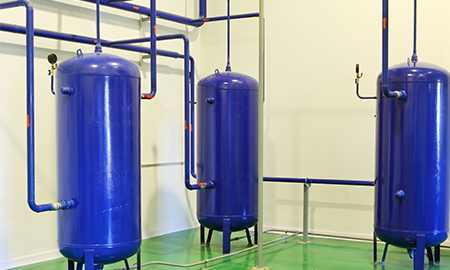Size matters!
Today most smaller air compressors are supplied with integral air receivers. The trend towards most manufacturers supplying compressors in a TAS (Total Air System) format is a positive one. It means you get everything you need in an air compressor in one, easy to install, small footprint unit. However, some people still buy compressors as stand alone units, so require a separate air receiver and dryer/filter package to work with the compressor.
I thought it would be useful to say a few word about air receivers, their purpose and most importantly their sizing.
Why do we need to use an air receiver?
- An air receiver is a vital part of any compressed air system. The receiver has 3 main purposes in any compressed air system:
- It acts as a storage vessel for compressed air storing it for later usage when demand increases.
- It acts as a buffer vessel, taking out some of the pulses that certain types of air compressor make eg piston compressors.
- It acts as a buffer vessel to smooth out demand on the air compressor, preventing the air compressor having to turn on and off frequently.
Lets look at each of these individually…
Storage vessel
This is the obvious purpose of the receiver. Having a large storage vessel means that increases in demand for air can be met from the storage vessel rather than from the air compressor. In applications where demand is very ‘peaky’ the bulk of supply will come from the receiver rather than the compressor. In some applications where there is a very short duration but high volume air demand, you will find a very large air receiver with a small air compressor. The air compressor will spend all day charging the large air receiver. When the air is required it is 100% supplied from the receiver with the air compressor then re-charging the air receiver over a longer period of time.
Buffer vessel to smooth out peaky supply
Piston compressors tend to have a very peaky supply profile with peaks in pressure / volume with when the piston is in compression and zero supply pressure when it is on its downward stroke. Most compressed air applications need a steady flow of air eg paint spraying, so a peaky air supply would be a disaster for product quality etc. A suitably sized air receiver smooths out this supply to give a steady smooth flow.
Buffer vessel to smooth demand on the air compressor
Air Compressors like to run, and don’t like to start up frequently. To reduce the number of start-ups in say, an hour, most compressors are designed to operate with ‘run on timers’. When the air compressor gets up to pressure rather than ‘turn off’ the compressor it runs ‘unloaded’ for a short period of maybe 3-5 minutes. After this time if there is still no air demand the compressor will stop. When the compressor is running unloaded it is still using about 35% of total power but creating no compressed air. This is effectively ‘wasted’ energy.
A larger air receiver will reduce the amount of time / frequency the air compressor is running unloaded so will save you money by not running in this energy wasting condition.
Air receiver sizing
Fixed speed compressors
As a general rule of thumb air receivers should be between 25% and 50% of the FAD (Free Air Delivered) of the compressor for fixed speed compressors. So a typical TAS 11KW compressor with a FAD of 1.67m3/min has a choice of either a 270l or 500l receiver. Based on the 25% rule the best size air receiver is 1.67*1000*25% = 417 litres. So, if space allows, the 500l tank is the most appropriate size.
However, having a bigger air receiver will help (particularly with fixed speed units) since it allows the compressor to run longer at maximum efficiency. Power savings can be significant with upto 10% savings being achieved with a receiver double the ‘rule of thumb sizing’
Variable speed compressors
For variable speed compressors the receiver size can be smaller around 10% of the FAD of the compressor. Variable speed compressors don’t tend to run unloaded so don’t have this period of wasted energy, they can also vary their speed to meet demand so the receiver doesn’t need to be so big. However, variable speed compressors do still need air receivers to smooth out downstream demand so they can adjust their speed efficiently.
Other things to consider
As with air compressors it makes sense to put receivers near to where most of the air is being used.
It is important that pipework is sized correctly both into and out of the air receiver. Pipework needs to be sized to cope with the maximum flow you are likely to see.
Air receivers are one of the main places that condensate collects. Make sure there is a good condensate drain system on every receiver.
Generally, the bigger the air receiver the better it is for your compressed air system, however it is important that you have enough physical space to put the air receiver whilst still being able to access the air compressor for servicing and maintenance.


